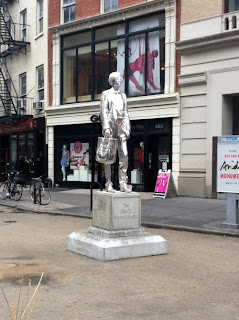Ludwig Mies van der Bear: Urs Fischer's Giant Teddy Bear Meets the Seagram Building
The steel and bronze Seagram Building (1958) by architect Ludwig Mies van der Rohe (1886-1969) at the corner of E. 52nd and Park Ave, set back from Park Avenue behind sleek fountains, stands as a paradigm for the well-made modern glass office building. Sleek, soaring, and minimalist, clad in bronze and glass, the building recalls the type of structure that the architect envisioned for Berlin in the 1920s. Along with Philip Johnson, who was responsible for the interiors, the Seagram influenced many copy-cats, but few were as successful in sensitivity to site or design. The building introduced the modern plaza, a space still frequented by midtown workers during pleasant weather.
Seagram Building, meet the bear. Starting officially today, Christie's is presenting the 23-foot tall Untitled (Lamp/Bear) (2005-2006) sculpture by Urs Fischer (b. 1973) to bring attention to its Post-War & Contemporary Evening Sale on May 11. The work is up for auction and expected to generate a lot of interest. The plan is for the work to remain in Seagram Plaza for five months, so let's get to know Urs and his bear. Urs, whose name means "bear" in Latin, drew upon his own teddy bear in creating the monumental work. It's a masterful work technically. A cast bronze exterior painted in yellow paint and lacquer covers a stainless steel interior support. The cuddly-looking bear defies its own materiality. Also, the bear leans against a table lamp, creating a charming informality. Importantly, the lamp actually functions, so the sculpture will take on a nice glow at night. The thing weighs 35,000 pounds, so Christie's partners at the Seagram Building had to shore up the plaza floor in order to support the big bear. This bear, like real bears, could crush and kill you.
In theory, there are few better places to site a sculpture of this stature, in terms of public spaces. The Street Life Project, a New York City Planning Commission study that began in 1969 to ascertain why some public spaces were consistently popular while others remained relatively empty, deemed the Seagram Plaza one of the city's great successes. The plaza attracted people to stop and sit down, to choose to mingle with friends or stay by themselves, to find a sunny or shady spot, depending on the weather, and to hang out and eat a sack lunch near the fountain. The elements that made Seagram Plaza successful and versatile were later incorporated into city guidelines for all new public spaces.
So, what happens when a giant yellow bear sits down in Seagram Plaza and leans against a table lamp? Without the bear, the plaza is still that place to sit down and eat lunch or meet friends or contemplate the masterpiece of Mies van der Rohe. But, it's a rather buttoned-down, decidedly grown-up, Midtown "Mad Men" sort of place. The Seagram Building is "serious." The presence of a monumental teddy bear, however, changes the mood and atmosphere. The bear is like a cute sweet kid who has just unexpectedly walked into his parents' sophisticated cocktail party. Some people drinking their martinis will enjoy this interruption. Others will not.
Ahhh, but who doesn't wuv a cute cuddly teddy bear?
 |
| Mies and the bear |
For a self-guided architecture walk of this general area, read the related post, A Walk for the Optimistic Modernist: From MoMA to the United Nations.
Images of Seagram Plaza by Walking Off the Big Apple from the afternoon of April 7, 2011.





I would say that Mies probably wouldn't wuv it, Teri. Here in Chicago, we have the Mies-designed Dirksen federal center. Alexander Calder's amazing Flamingo sculpture was installed after Mies died. Many think he would have flipped his less-is-more lid if he'd been around when it happened.
ReplyDeleteThat said, we're coming to NYC next weekend! I haven't seen the Seagrams Building in all my visits and have always wanted to. Thanks for the reminder, Teri--I may just have to grin and "bear" it and see it the way Mies wouldn't have wanted it seen.
Thanks, Terry. Mies probably wouldn't like it in front of his building, but I think the bear kinda looks like Mies. I'm not done with the Bear quite yet. The next post will suggest a good walk to see the bear and nearby architectural attractions. So glad you're coming to the city!
ReplyDeleteFor a few decades the plaza has been a favorite place of mine to just sit and watch the world go by. Sometimes I read, but usually just watch people and traffic and look up at the buildings. The strict, simple geometry of the architecture is complemented by the lines of the street grid in a way that is very relaxing to me and quite serene.
ReplyDeleteSo much of my personal image of New York was formed before I ever saw it by movies of the 50s and 60s and this stretch of Park Avenue seemed to be used a lot in those films. I expect to see Rock Hudson and Doris Day pass by any minute.
You're right, Teri--it does look like Mies! Probably another reason he would disapprove. The Seagram Building and the bear are now definitely on our list.
ReplyDeleteAnd Phil, I totally understand what you mean about having your image of New York formed by movies (and TV, for that matter) before ever getting there. Even on my first visit to New York, so much of it felt so familiar.
ReplyDeletePhil, I loved your comment about images of NYC being formed by Doris Day-Rock Hudson pictures. Now I want to see a few of these, like "Where Were You When the Lights Went Out?," a Doris Day film about the 1965 blackout. http://www.dorisday.net/where_were_you_when_the_lights.html
ReplyDelete